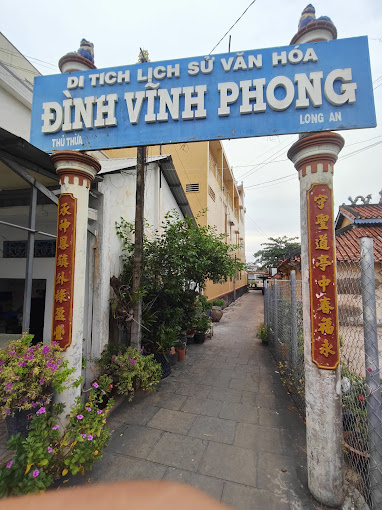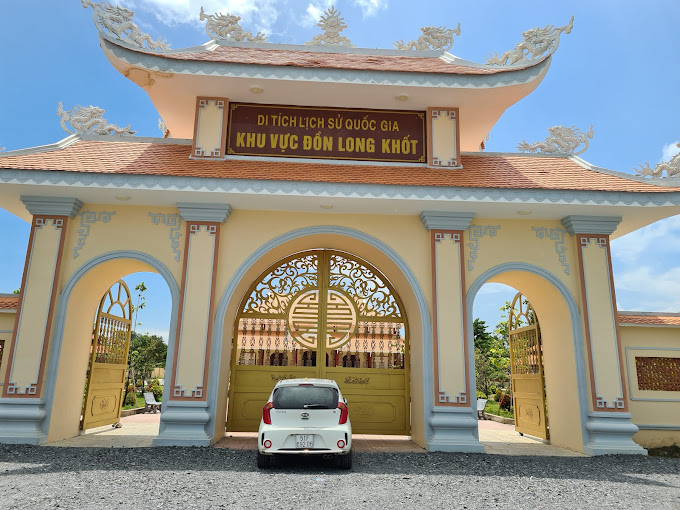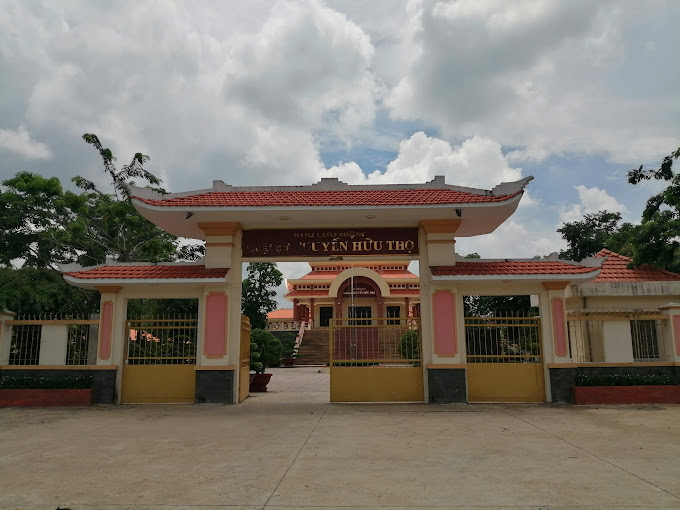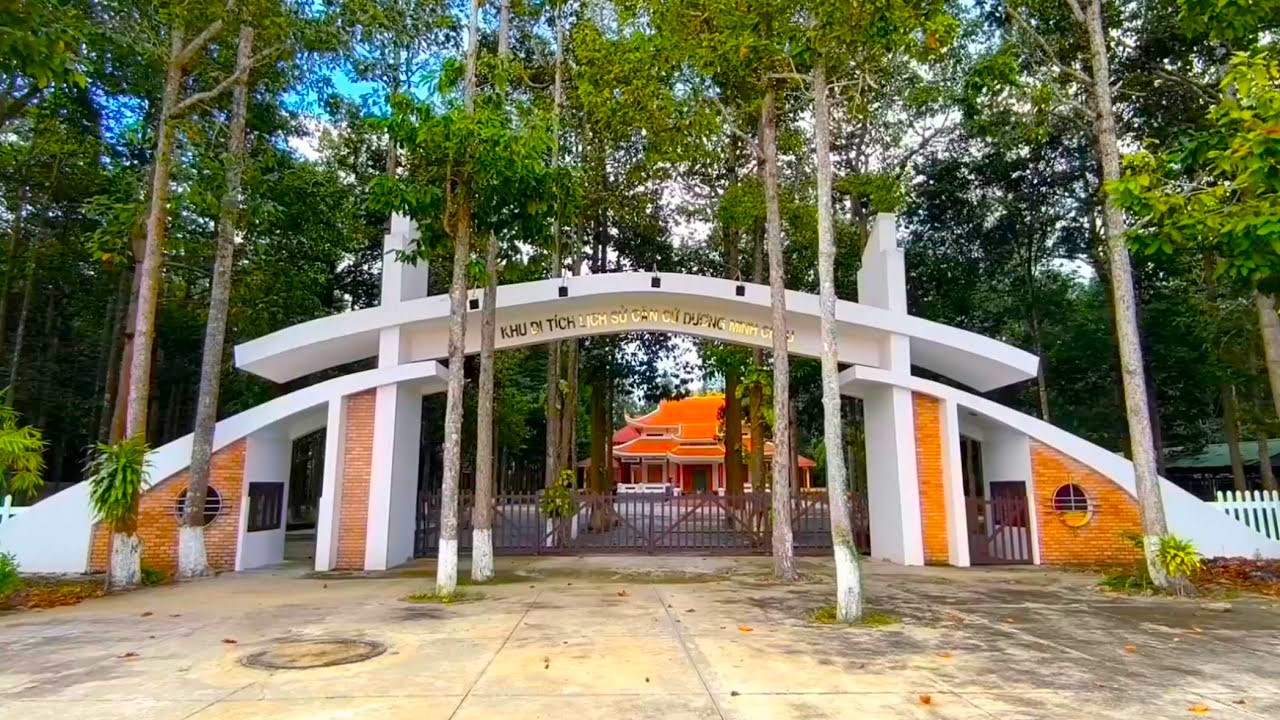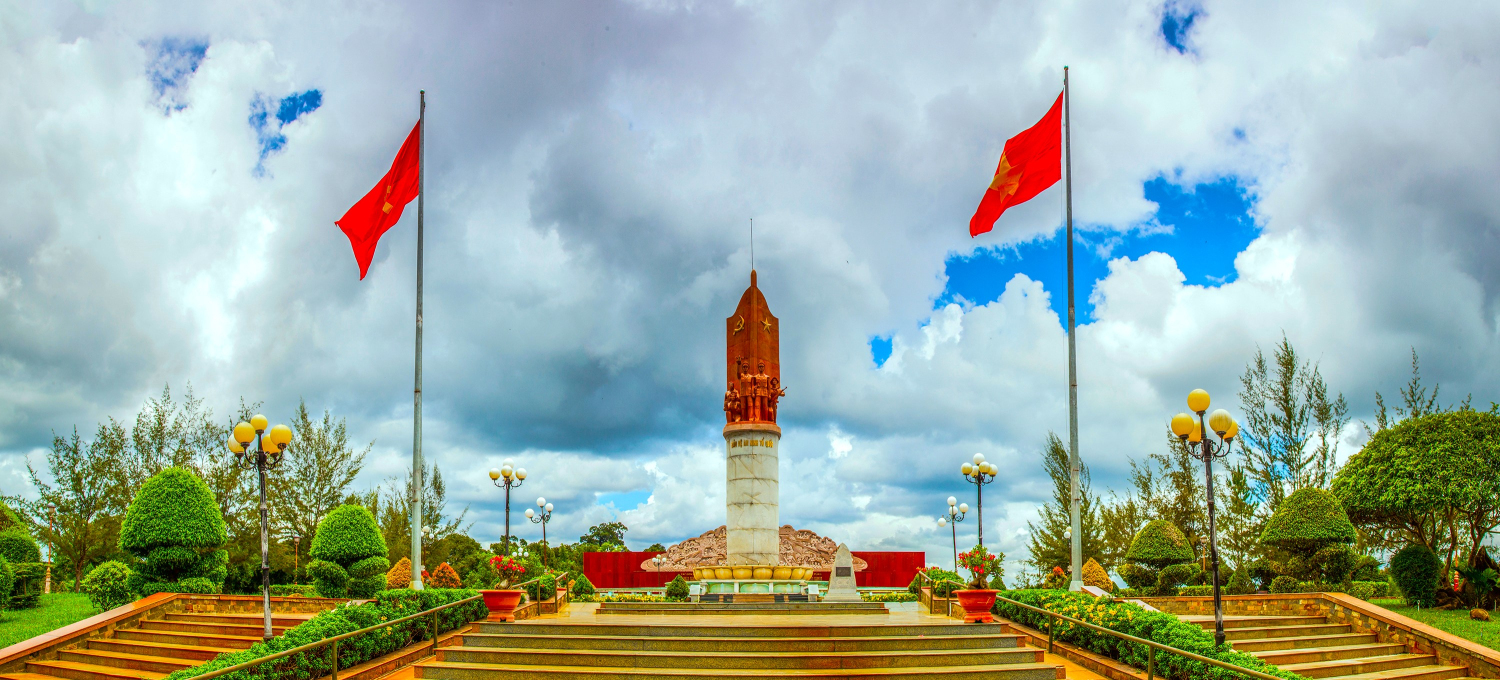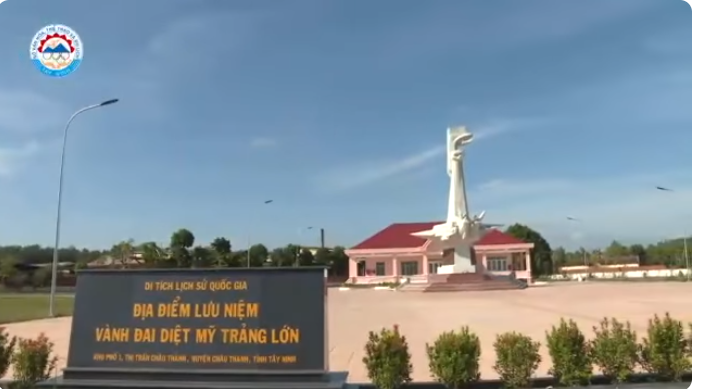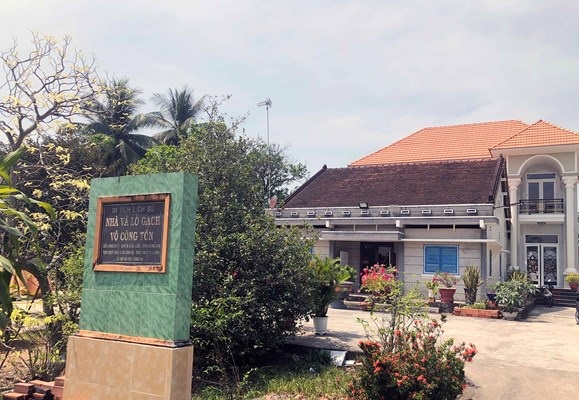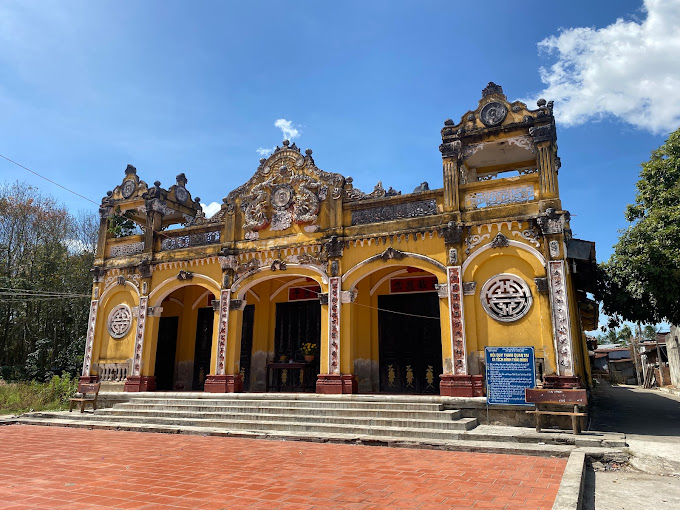Relic point Vietnam
Việt NamDinh Vinh Phong
Vinh Phong communal house is the ancient communal house of Vinh Phong village, now belonging to Thu Thua town dating back to the early nineteenth century. Vinh Phong communal house, where Mr. Mai Tu Thua's memorial, who has publicly established the village and established a market to create the prosperity of Thu Thua town today. At the end of the eighteenth century, Mr. Mai Tu Thua went to Binh Luong Tay village to reclaim a 4 -piece soil string along the Tra Cu (prayer) and take a small shop on the shore to trade. Because his shop was adjacent to Kinh Tra Cu country, the boat was gathered to buy and sell, exchanging very crowded, the population came to live more and more. Therefore, Mr. Mai Tu Thua covered the road, made a boat and established a market with leaf to have a place to buy and sell, which is Thu Thua Market today. Gradually, the population surrounding the developed market area, Mr. Mai Tu Thua immediately applied to separate from Binh Luong Tay village, establishing a new village named Binh Thanh village. He also donated a plot to store the communal house - it was the precursor of Vinh Phong communal house today. Legend has it that Mr. Mai Tu Thua contributed many of the dredging Tra Cu Kinh in 1829 and participated in the uprising of Le Van Khoi and disappeared. Therefore, his property consisted of a market and land was sung by the court and forever, his wife and children were exiled. Binh Thanh village, Lap, was also renamed Vinh Phong village, the communal house was also moved to another place. After all, when the French colonialists occupied the South, the Nguyen Dynasty had no force in the South, so the people around Thu Thua market just raised the money to rebuild Vinh Phong communal house in 1886 and put the article Mr. Mai Tu Thua to worship with 7 Han Han: '' Tien Mai Tu Thua - Chu Thi ''. Through many restoration, the nearest in 1998, Vinh Phong communal house still retains the architectural style at the end of the Nguyen Dynasty. Currently, Vinh Phong communal house is located in the area of 1132m2 with 3 classes: Vo Ca, Vo Quy, the main hall looks out the prayer. The Chief Justice of Vinh Phong was built in an ancient way with the structure of the four pillars, the roof of the yin and yang tile, the roof was with a pair of dragon with crockery in the long -bisexual position. Inside the main hall is decorated very solemnly with 2 layers of blue bags, 3 altars, Long Dinh and Lu Bo. Bao Lam outside is the masterpiece of the writer Dau Dau Mot, the Year of the Horse (1918). The artisans have shown on this bag of traditional topics such as Tu Linh (Long, Lan, Quy, Phung), Tu Huu (Mai, Lan, Cuc, Truc), Ba Dieu Quy Sao. Above, there are wooden frames structured in the style of the dragon bucket, the image of Long Ma, Mai Loc, Thu Thu, fish Hoa Long, Bat, very sophisticated. In front of the altar is the Co Lam Co Bao dating back to Binh Tuat (1886). It is still the topic of the Four Front, but the details on this set of lames are posed strong and strong in the late nineteenth century. The special feature in this lam is the art of painting the golden lacquer very sophisticated. Over the period of more than 100 years, this set of lames remains the same as the beginning. The Chief Justice of Vinh Phong has 2 ancient diaphragm and 8 couples with the value of the Dog (1886) and Binh Thin (1916). Most of the sentences are written in the way of the player (the first 2 words of the two sentences combined into the name of the family or the Thu Thua name). Especially, the couple in the altar of Mr. Mai Tu Thua highlighted his great merits and the deep gratitude of the people of Thua Thua to him. Because of that, today a series of landmarks in Long An are set as Thu Thua such as Kinh Thu Thua (Kinh Tra Cu), Thu Thua Market, Thu Thua District (dating back to 1922). On the old land, Mr. Mai Tu Thua has resolved, established a market, established a village, dredged and revealed, today is a crowded residential town, a prosperous economy, Vinh Phong communal house is still there to remind us of a past time. Coming to Dinh Vinh Phong, we admire the talented carvings of artisans in the past, understanding more about the great contributions of Mr. Mai Tu Thua in the process of exploring the land of our ancestors. With that meaning, Vinh Phong communal house was ranked as a national monument by the Ministry of Culture and Culture as a national monument on August 31, 1998. Source of Electronic Information Portal Long An Province
Tay Ninh 2366 view
Don Long Khot
National historical monument (KDTLS) in Long Khot station area is the place where the dedication and sacrifices of officials and soldiers (CBCS) Division 5; Units coordinated in the period 1972-1975 and 43 days and nights of Long An Border Guard in protecting the Southwest border in 1978. Currently, the monument is upgraded, a day not far, this place will be a traditional educational destination for the younger generation. Long Khot is a place in Thai Binh Trung commune, Vinh Hung district, bordering Vietnam - Cambodia. In the two wars of national liberation and defense of the Fatherland, Long Khot was a fierce dispute between us and the enemy. From June 1972 to April 30, 1975, the 5th Division coordinated with the local force of Kien Tuong to constantly attack the enemy with many fierce battles, suffered many losses and sacrificed to liberate by the line to prevent the enemy in Dong Thap Muoi. In particular, the two large -scale attacks in the Long Khot branch (June 1972 and April 1974) made the enemy seriously damaged. Particularly, the battle against the 1974 championship, completely liberating the branch, opened the border corridor. Hundreds of soldiers and officers of the 174th Regiment, the 5th Division and the coordinates were here. The anti -American resistance ended, the land of this border area did not fully enjoy the joy of unity, the southwest border war broke out. The dragon base (now the Long Khot Border Station) once again is a very fierce fighting point. The Pol Pot had gathered forces to occupy Long Khot as a springboard to attack deep into our rear. Cadres and soldiers of Long Kho dancer persevere in their heads, overcome difficulties, coordinate with local armed forces to fight tenacious and brave, prevent enemy attacks, maintain every inch of sacred land of the Fatherland, protect the life and property of the people. Over 43 days and nights, from January 14 to February 27, 1978, Long Khot stationed 21 attacks of the enemy, fought 28 matches, destroyed 55 enemies and injured dozens of other men. In this tenacious battle, with a thin force, our troops sacrificed 26 people (10 soldiers of the station, 16 comrades of friends) and 20 injured. The heroic fight and the noble sacrifice of the heroic martyrs contributed important to the overall victory of the national liberation and defending the Fatherland. With those glorious achievements, on December 20, 1979, Long Khot Border Station was honored to be commended by the Party and the State to the title of Hero of the People's Armed Forces. In the process of collection and statistics (incomplete), in the period 1972-1975, the 5th Division had 1,110 officers and soldiers who died on the Long Khot battlefield; In particular, the 174th Regiment has nearly 800 soldiers. On May 19 every year, at the relics of Long Khot Station maintained a ceremony to grateful to the heroic martyrs and the folk death anniversary (martyrs' anniversary) into a local traditional cultural and spiritual festival. Is an important convergence in the community, preserving cultural traditions, meeting the spiritual needs of relatives of martyrs and a large number of people near and far. Historical relics of Long Khot station area contain historical values, national security, culture and humanities. With these values, the monument has been issued by the Ministry of Culture, Sports and Tourism Decision No. 1792/Decision -The Culture, Sports and Tourism Culture, Ranking of Long Khot Don area is a national monument. This is an important basis to identify the great dedication and sacrifices of the 5th Infantry Division, the army and the Long An people in fighting against foreign aggression and defending the Fatherland, which is a favorable condition for the planning to build relics to become a historical, cultural and defense project worthy of valuable values, and a place of respect and solemnity for today's children and grandchildren. Source of Electronic Information Portal in Long An Province.
Tay Ninh 2380 view
Lawyer Nguyen Huu Tho
The Memorial Area (KLN) Lawyer Nguyen Huu Tho has been ranked as a national cultural and historical monument in 2015. Since then, the relic area has become a traditional red education address, especially for young generations inside and outside the province. The life and career of the late lawyer Nguyen Huu Tho is a good example of patriotism, helping the generation today and tomorrow have the motivation to nurture trust and ambition. Lawyer Nguyen Huu Tho's Memorial Area in Ben Luc town, Ben Luc district, Long An province has an area of 10,000m2, including items such as memorial temples, meeting rooms - display areas - libraries, green parks, grass, souvenir trees and other auxiliary items. Lawyer Nguyen Huu Tho is the excellent son of Long An. He was born on July 10, 1910 in Long Phu village, Long Hung Ha, Trung district, Cho Lon province (now in Ben Luc town, Ben Luc district, Long An province). He participated in the revolution in 1947, repeatedly captured and imprisoned by the enemy, but that could not stop him from following the path of national liberation. After the country was unified, he made great contributions to the country, was elected many important positions: Vice President of the Socialist Republic of Vietnam; Acting President of the Socialist Republic of Vietnam; Chairman of the National Assembly, Vice Chairman of the State Council; Presidents of the Central Committee of the Central Committee of the Vietnam Fatherland battle. He was awarded the Gold Star Medal and many other noble medals both at home and abroad. The gallery of life and career of lawyer Nguyen Huu Tho has full information, images and artifacts about lawyer Nguyen Huu Tho and is divided into different stages. In particular, the gallery has some valuable artifacts, attached to the lawyer at the time of donation by the family such as the clothes, the stick of the lawyer, the radio that the lawyer often carries with him to hear the news, ... All clearly reproduce the process of growing up, learning and participating in the revolutionary of the elite son of Long An and leaving strong impression in the heart of the visitors. The memorial temple is a place to express respect, commemorate the late lawyer Nguyen Huu Tho, former President of the State, Chairman of the National Assembly of the Socialist Republic of Vietnam. The memorial space is designed with bold Southern cultural identity, exuding solemnity with deep colors as the main color such as brown, creamy yellow, wood color and color of lacquer paintings, diaphragmas are painted with golden cards. Lawyer Nguyen Huu Tho with copper material is solemnly placed in the central position in the temple with two elaborate carved altars. Inside the temple decorated many dragon images according to Vietnamese cultural and spiritual traditions. In the souvenir area, there is also a body gallery and career of lawyer Nguyen Huu Tho. With artifacts, documents, maps, paintings, models, tables ... The gallery introduces the homeland, the human country and the career of lawyer Nguyen Huu Tho. Besides, typical artifacts associated with lawyer Nguyen Huu Tho are also displayed. Source of Electronic Information Portal in Long An Province.
Tay Ninh 2300 view
Binh Thanh base
Binh Thanh is a low -lying land with many bonds mixed with high soil creating a fairly complex terrain in Duc Hue district, Long An province. This area is located between the east and the Southwest region, close to Saigon and leaning against Cambodia. With these conditions, Binh Thanh has become a unique base in two wars against the French colonialists and American imperialism. Since the Nam Ky uprising (November 23, 1940), more than 100 Tan An insurgents were large under the leadership of the comrades Luu Du Chau and Le Van Tuong to the Binh area to establish a green base. This base only exists for 8 months, there is an order to disperse of the Party Committee, because there is no conditions for the 2nd uprising. However, the green base has created a premise for the formation and development of the provincial Party Committee later. During the anti -French resistance war, Binh Thanh area was the base of Cho Lon Provincial Party Committee and Area 7 with the name "Dong Thanh Military Region". Southern agencies such as the Office of the Southern High Command and the Departments of the Southern Administrative Resistance Committee also had time to station in the Dong Thanh Military Region. After the 1954 Geneva Agreement, the government of Ngo Dinh Diem straightened the revolutionary forces. In order to preserve the forces, a number of officials and party members of the two provinces of Tan An- Cho Lon have withdrawn to the vase. In the context of the Central Government that did not allow the armed struggle, revolutionary soldiers in Binh Thanh took advantage of the name of the sectarian troops to establish the South Central Command- the first armed forces of the 8 and Southern region after 1954. In July 1957, the Party Committee established Long An province on the basis of merging 2 provinces of Tan An and Cho Lon. With experience from the anti -French resistance war, Long An Provincial Party Committee chose Binh Thanh as a base for the leadership of the resistance against the US. In each period with different difficult and favorable conditions, Long An Provincial Party Committee was flexible and maneuverable in Binh Thanh area, sometimes having to temporarily flee to three autumn, sometimes developing to Duc Hoa, Ben Luc and the lower areas. However, the place where Long An Provincial Party Committee and its affiliated agencies stood the longest operating was the friend of Binh Thanh area in the opening period and ending the resistance war against the US (1960-1961)-(1973-1975). From Binh Thanh base, the Provincial Party Committee promptly directed and set out guidelines, resolutions and leaders of the revolutionary movement in the province until the day of complete victory. With an area that is not wide, the terrain is rugged but it cannot be completely based on that to survive and against the modern war vehicles of the enemy, but the Binh Thanh base is still challenging to the enemy. This is thanks to the people's love and love, the flexibility and creativity of the Provincial Party Committee. It can be said that Binh Thanh base is the base of the people's heart. With the spirit of drinking water to remember the source, in 1996 the Provincial Party Committee and the leaders of Long An province have returned to Binh Thanh, identifying points that the Provincial Party Committee used to work in the past. The Management Board of the construction of revolutionary historical relics was also established with the task of restoring the embellishment of historical relics of Binh Thanh base with an initial scale of 93 hectares in Binh Hoa Hung-Duc Hue commune. In 1998, the Ministry of Culture and Information issued a decision to rank Binh Thanh base as a national historical monument. A project of constructing memorial works such as temples, beer, radio ... and regenerating the original monuments is outlined and gradually implemented so that in the future, visitors can partly understand the living and fighting situation of our officials, soldiers and people during the resistance period. Source of Electronic Information Portal in Long An Province.
Tay Ninh 2465 view
Ancient Housing Cluster Thanh Phu Long
Thanh Phu Long's ancient housing cluster was built in the late nineteenth century - early twentieth century by the Nguyen family, the rich class in this land. With the nickname "rich neighborhood", the houses here are not only impressed by the massive scale but also by the sophisticated beauty in every architectural detail. The monument cluster consists of three large houses, each house is 528m², located on a land of 15,000m². The architecture of the house (the front house) and the cross -style house (the back house) is in the middle style, designed in the shape of the word, cleverly combined with Western elements in the facade. The highlight of this old house cluster is the extremely delicate and rich wood carving art. The patterns are vividly portrayed with traditional topics such as "Four Spirit", "Bat Buu", or images close to the Southern life such as "mango birds", "crabs", "Sen Le". Many rare artifacts such as nacre snail cabinets, bronze censer, golden painted lacquer and ancient pottery from the nineteenth century were still stored intact, reflecting the prosperity of the upper class of that period. About the art of decoration is quite rich and diverse in expression. In addition to traditional topics, the natural scenery of the South is taken into the work by artisans in a harmonious and creative manner. Regarding wood carving techniques on architectural works, showing the surface of the experiences and talents of artisans; The coordination of diverse, dual techniques with skillful and firm tactics. The wooden architectural works, the artworks of Thanh Phu Long ancient house cluster show a master's master of the central carpenters, the Southern wooden craftsmen in the architectural structure processing, technical processing, topics layout, diverse and attractive decoration. With the above values, in 2007, the old house cluster was ranked by the Ministry of Culture and Information. Source of the website of Thanh Phu Long commune, Chau Thanh district, Long An province.
Tay Ninh 2490 view
The relics of Duong Minh Chau base
Duong Minh Chau relics are located in Phuoc Ninh commune, Duong Minh Chau district, Tay Ninh province. Duong Minh Chau is the name of the Chairman of the Administrative Resistance Committee of Tay Ninh Province, who sacrificed heroic in the battle of France to Ben Cay Cho Ben Ben (now in Go of Hamlet, Ninh Dien Commune, Chau Thanh District, Tay Ninh Province). On February 7, 1947 to engrave the gratitude and commemorate comrades, the province took the name Duong Minh Chau to name the base. The policy of building a base, a place to stand to build a forces for the long -term resistance war, has been posed quite early by Tay Ninh province, from the early days of preparing to revolt Nam Ky. In 1948, due to the requirements of the provincial resistance war, he decided to choose the tea area as a base of the province, including zone 4, zone 6, adding the land of Ninh Thanh, Hao Duoc and Hoa Hiep communes. During the resistance war against the US to save the country, in the face of the new task, Duong Minh Chau base continued to expand and develop widely to the northwest and north of the Cambodian border. Duong Minh Chau base has a terrain location that is considered an important strategy, converging the properties of three strategic areas, in which the mountainous area occupies a special position, can be continuous at the back, a large forest area to eat up to the Cambodian border, closely related to the war zone D. This mountainous area is eligible for "heavenly, geography, harmonious people" to build a base of the base of the base, the base of the resistance and the resistance system Advantages with the command and direction of the entire resistance war. Duong Minh Chau base is like a thorn that stabes the enemy's eyes. The enemy was "pacified" and "destroyed", and we were determined to protect and maintain the "holy land", the district base Duong Minh Chau and other base areas were both rear and a hot strategy, struggling between us and the enemy during the resistance against the US from the local war, Vietnam turned the war. In the Ho Chi Minh campaign, Duong Minh Chau base is one of the gathering places of the main force to advance to liberate Saigon. In the world, the speed of the army and people of Duong Minh Chau and the Tay Ninh army liberated himself, contributing to the end of the victory of the resistance war against the US to save the country. Duong Minh Chau base relics have been recognized as a national historical and cultural monument in Decision No. 61/1999/Decision - September 13, 1999 of the Ministry of Culture and Information (now the Ministry of Culture, Sports and Tourism). Source of the website of Thanh Tan commune, Tay Ninh province.
Tay Ninh 1936 view
Pursuant to the Central Security Department of the Southern Department
In the war against the US to save the country, since its establishment in July 1960. The regional security committee is a agency under the Central Administration of the South, constantly clinging and building a base in the North Tay Ninh battlefield. After 15 years of fighting and maturing with 8 moving and building base. At the end of 1972, the Security Committee returned at Seven Bau, Tan Lap commune, Tan Bien district, Tay Ninh province until April 30, 1975. The relic area of the Central Security Department of the Southern Department has been ranked as a national historical monument in Decision No. 3777/Decision - The Head of December 23, 1995 of the Minister of Culture and Information (now the Ministry of Culture, Sports and Tourism). In the embellishment area, there are 32 beer houses of the security forces of the southern provinces from Quang Tri to Ca Mau. Each locality has a unique style, a unique symbol, depicting the specific traditional image of each land, but all focused and highlighted the hero of the word "Quan rang the mother of Quang Tri hero, to the indomitable Central Highlands, to Quang Da Trung as resilient. From Vung Ro connects waves to Dong Khoi's hometown Ben Tre, from Bac Hero hamlet to Kien Trung Hon, from Sac-Nha Nha forest to Binh Long, Phuoc Long built a victory. From U Minh, Dong Thap to Cu Chi steel soil to Dong, they all converge to Tay Ninh, where the seven Bau base was a time of resistance. ” This is a relic area, a quite attractive tourist destination, because the forest landscape of the war zone is preserved intact, the trenches, roads, houses have been restored and embellished in time with many beautiful works, especially the high monument blended into the vast forest tree space to create a majestic beauty depicting the glorious feats of the Southern Revolution. Source of the website of Tay Ninh province.
Tay Ninh 1839 view
The souvenir souvenir to kill the US
The souvenir souvenir to the elimination of My Trang Lon is located in Chau Thanh town, Chau Thanh district, Tay Ninh province. Trang Lon was previously chosen by the US military to be built, both a military base and a logistics for many other bases such as Pan and Thien Ngon. From October 1965 to April 1972, this place is the base of the US Infantry Division No. 25, called "tropical lightning". Before the plot to expand the war of the US, Tay Ninh Provincial Party Committee advocated the establishment of the battle surrounding the base of Trang Lon base, forming a closed American elimination belt. The elimination belt of Trang Lon was one of the first three belts to kill the US first in the Southeast, including 8 communes surrounding the US 196 Brigade base. Born, existed and consolidated, developed, and the belt of destroying American Trang Lon has made battles consuming and destroying many enemy vitality. The belt of eliminating the big office is a creation, a feature only in the big party, has gathered the hearts of people, created the power of synthesizing the enemy with three armor, 3 zones, with three troops, creating many ways of fighting the enemy: fighting at the base, combining large fighting, beating, hitting continuously, always fighting, always struck, enemy waist, enemy feet. The belt of destroying Trang Lon and many other places in Tay Ninh province has promoted the great role and effect during the years the US sent troops directly to fight in Tay Ninh, contributing to clarifying a unique phenomenon, a form of creative enemy, a brilliant expression of the people's war. For Tay Ninh, this is also a symbol of the tradition of "Tay Ninh Trung Dung resilient". With 2,250 days and nights fighting on the belt of destroying the My Trang Lon (from October 1965 to April 1972), the Party Committee and the people of Chau Thanh district conducted 3,825 battles of Wei and Binh Dinh, making many glorious achievements, contributing to the whole country to defeat the "local war" strategy. The location of the Dai Trang Lon Kill belt has been ranked as a national historical monument in Decision No. 3990/Decision -The Culture and Sports Culture and Tourism on January 12, 2013 of the Ministry of Culture, Sports and Tourism. Source of electronic portal of Chau Thanh district, Tay Ninh province.
Tay Ninh 1912 view
Historical relic of Vo Cong Ton House and Brick Kiln
Vo Cong Ton's house and brick kiln are a place to commemorate the patriot Vo Cong Ton - who devoted a lot of his life and his life to the Party during the pre-uprising period (1930-1945). The reason the relic is called Vo Cong Ton House and Brick Kiln is because this is an architectural whole consisting of two points: Mr. Vo Cong Ton's house and the brick kiln owned by him. Vo Cong Ton House and Brick Kiln is located in Lo Gach hamlet, Long Hiep commune, Ben Luc district, Long An province. Vo Cong Ton House was built around 1910, in the style of Cong letter, three compartments, two wings with concrete materials and tile roof. In 1984, due to deterioration, the house was demolished, only the foundation, floor, and tiles were reused to build a new house with an area of 128m2. The interior decoration of the house has the common style of well-off houses of the late 19th century with panels, horizontal panels, and parallel sentences. What stands out in Vo Cong Ton's house are the many lamellas with diverse themes vividly expressed by elaborate techniques of carving, embossing, and conch engraving, which are valuable in terms of sculpture and wood carving. Vo Cong Ton's rice granary is where Uncle Ton Duc Thang opened a class to spread anti-French colonialism in 1928. The brick kiln is where Vo Cong Ton produced and traded bricks and tiles to create a financial source for the Party. Trusted base of Cho Lon Party Committee, Southern Party Committee and patriotic movements before 1945. In 1927, Nguyen An Ninh was a revolutionary, writer and journalist. He founded the patriotic organization Thanh Cao Vong Party, but in 1923, Vo Cong Ton worked side by side with Nguyen An Ninh in journalistic work. Open schools to raise people's knowledge, propagate and awaken the national spirit for the masses. Short-term classes are regularly held at the Vo Cong Ton brick kiln area directly taught by Nguyen An Ninh. train and attract a large number of brick kiln workers. In 1935, the Party Cell of Lo Gach hamlet was born in the Vo Cong Ton brick kiln area. All activities and meetings of the Party Cell take place here. In 1936, Nguyen An Ninh and Nguyen Thi Minh Khai opened a 20-day class to propagate revolutionary movements and spread Marxism-Leninism to a large number of brick kiln workers. In 1937, 40,000 leaflets protesting the governor-general of Brevie and labor inspector J.Godart to Vietnam were also printed at Vo Cong Ton's brick kiln. Leaflets printed from brick kilns were scattered everywhere from Saigon Cho Lon to Tan An and My Tho. The brick kiln area is where Vo Cong Ton directly produces and does business, sometimes with more than 300 workers. This place is an important financial source for the Party. The patriots were active in the early years of the Party's youth. Vo Cong Ton House and Brick Kiln were recognized by the Ministry of Culture and Information as national historical and cultural relics on January 19, 2004. Source: Long An Provincial Party Committee Information Portal
Tay Ninh 4024 view
Thai Binh communal house
Thai Binh Communal House is one of the ancient communal houses with a harmonious decorative architecture that preserves traditional national art and is modern, located in Quarter 4, Ward 1, Tay Ninh City, Province. Tay Ninh. Thai Binh Communal House was built over 100 years ago to worship the God Hoang Bon Canh Vo Van Oai - a mandarin of the Hue court who fought against invaders from across the border and martyred himself in this area. On March 18, 1917, King Khai Dinh, in his second year, ordained Thai Binh communal house. The communal house was majorly repaired in 1950. The communal house's grounds are 1,700 square meters wide, the vestibule faces Southeast, the facade is embossed with scroll symbols: books and swords, on both sides there are bell towers, drum towers, and the top of the communal house's roof. There are two dragons flanking the moon. The interior is decorated with diaphragms: "Peaceful scene" and "Divine inspiration". Along with pairs of gypsies, phoenixes, pine trees, chrysanthemums, bamboo, apricot blossoms and worshiping objects. On December 12, 1994, Thai Binh Communal House was ranked by the Ministry of Culture and Information as a national historical-cultural relic and was restored and renovated in 2013. The annual Ky Yen Festival is held on the 15th and 16th of the 11th month (lunar calendar), with an ordaining procession, opera singing, martial arts demonstrations and other folk cultural activities. Source: Provincial Department of Culture, Sports and Tourism
Tay Ninh 3766 view
